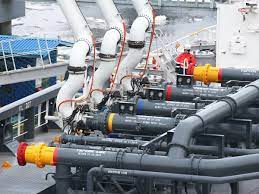According to ship monitoring, traders, and shipping sources, commodity dealers such as Trafigura and Vitol helped keep Russia’s oil flowing through its Baltic and the Black Sea ports in March when other Western corporations began to shun the market.
Both Swiss trading institutions have long-term agreements to load crude with Rosneft, the state-run Russian oil giant, under accords reached before Moscow’s invasion of Ukraine provoked a wave of Western sanctions this month.
According to Refinitiv Eikon ship tracking data and sources, the two businesses have loaded 22 cargoes of Urals crude so far in March, equivalent to 2.32 million tonnes of oil or 16.7 million barrels. In February, they transported 1.84 million tonnes, up from 1.80 million in January.
The two businesses acquire the majority of their oil from Rosneft, but a considerable portion of the crude Vitol transports through Russian ports originates from Kazakh suppliers.
The imports have not violated any Western regulations, and several European countries continue to purchase Russian gas, despite the fact that some Western companies, such as Shell and BP, have stopped buying Russian oil on the spot market.
According to shipping statistics and information from merchants, other Swiss-based traders Glencore, Gunvor, and Petraco loaded Russian oil in March, though the volumes they took were slightly smaller than in prior months.
The loading data provides an early indication of how the Ukraine crisis is likely to reshape the global oil market, as rising prices, volatility, and the potential of sanctions make trading more difficult.
According to shipping data as of March 25, Trafigura is experiencing its busiest month since June, when it loaded 12 cargoes of Urals. According to data and trading sources, its monthly average from the start of 2021 to February was 8.3 cargoes.
Vitol’s ten shipments are on a level with February and January and are roughly in line with an average of 9.6 since the company’s October arrangement with Rosneft began. For the first nine months of 2021, the monthly average was 5.1 cargoes.
Benchmark Brent crude hit its highest level since 2008 this month on concerns about U.S. and European curbs on Russian oil shipments. Meanwhile, Urals crude has been trading at historic lows compared to Brent pricing.
PRECAUTIONS TO BE TAKEN
Since the Ukraine conflict, which Moscow refers to as a special operation, began on February 24, Trafigura and Vitol told reporters they were completing existing contracts and had not negotiated any new arrangements for Russian oil. They declined to remark on the amount of Russian oil they have purchased.
While the long-term contracts aren’t public, three sources told reporters that Trafigura has a deal that will last at least until next year, while Vitol’s will last at least until October. According to the sources, the contracts provided the corporations a lot of leeway in terms of how much oil they could buy each month.
The firms have previously refused to comment on the terms of the deals to reporters.
“We are continuing to meet our legal duties deriving from existing term agreements signed before to the conflict in Ukraine,” a Trafigura spokesperson stated.
“We are taking every precaution to ensure that we comply fully with all applicable regulations and sanctions,” the spokesperson said. “We continue to engage with customers and governments to understand their requirements and provide the commodities and energy they require in a severely disrupted commodities market.”
Deals for April are still being finalized, but Trafigura has eight cargoes lined up for the first ten days of the month, while Vitol has six. In May, the corporations will provide Russian oil known as ESPO Blend, which is exported through Asian ports.
On March 15, the European Union restricted dealings with a number of Russian oil businesses, including Rosneft. Brussels, on the other hand, offered contracts already signed a two-month cooling-off period and exempted acquisitions that were “strictly necessary.”
According to dealers, European oil refiners are presently analyzing what the new EU sanctions entail for Russian crude purchases, and some are shopping for oil elsewhere while waiting for confirmation.
Trafigura and Vitol are anticipated to continue buying crude from Rosneft in April and May, although not at the same volume as planned due to potential issues selling the cargoes to EU clients, according to oil dealers.
NO BRAND NEW COMPANY
TotalEnergies , Shell, and Exxon Mobil, as well as Neste from Finland, all loaded cargoes of Russian oil in March.
The majority were ordered early in the month, prior to the invasion, though on March 4, Britain’s Shell purchased a substantially discounted cargo of Russian oil from Trafigura. Shell had promised a few days before to terminate its business in Russia, but following a barrage of criticism, it eventually apologized for the trade.
Some Urals shipments scheduled for loading by Western companies in the second part of March have been canceled. Shell, Neste, and TotalEnergies have said that they will no longer make fresh spot purchases of Russian oil. Exxon did not immediately reply to a request for comment.
Petraco, a trading business, told reporters that the Russian oil it has loaded or is due to ship was contracted before the invasion of Ukraine and that it rigorously follows government laws.
According to dealers, Petraco has a long-term contract with Russian oil giant Neftisa that expires in 2022 and a short-term contract with state-controlled Zarubezhneft that expires in March.
From October through March this year, both Gunvor and Glencore had Urals purchase tenders with Rosneft, and most of the Russian crude loaded fell under those contracts. According to dealers, neither ship is likely to load any Rosneft oil in April.
According to reporters, Gunvor will not conduct any new business with Russia, but a source close to Glencore indicated the company was only handling oil from pre-invasion contracts.
ARE YOU GOING TO ASIA?
According to the loading schedule for March, Russia aims to export 6.2 million tonnes of Urals oil from Baltic ports and 2.28 million tonnes via Novorossiisk in the Black Sea.
While the final destination of some shipments may alter, Russia’s total export amount for March is projected to be broadly in line with its expectations prior to the invasion.
According to shipping records, the majority of the oil delivered in March will go to Europe, with approximately a third going to India and China.
Given the reluctance of EU consumers to take Russian crude, traders estimate approximately half of the oil planned to flow to the Amsterdam-Rotterdam-Antwerp refining and storage hub to be offloaded onto larger tankers and shipped to Asia.
According to shipping data, Litasco, the Swiss trading arm of Russia’s Lukoil, has one of the greatest shares of Russian seaborne crude exports in March, with 1.5 million tonnes scheduled to be loaded. Litasco did not respond to a request for comment.
According to tracking and trading sources, China’s Unipec, the trading arm of Asia’s largest refiner Sinopec, took six Urals cargoes in March. A request for comment from Unipec was not returned.
Traders said several cargoes of Russian crude slated to be loaded at the end of March had not yet been assigned to tankers, casting doubt on whether the loadings will take place.
Three trading sources noted that while Swiss trading businesses have been loading Russian oil, not all of their tankers have firm destinations at this time.
“It’s one thing to load the oil; it’s another to locate a buyer,” a petroleum trader in the Urals explained.

















